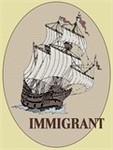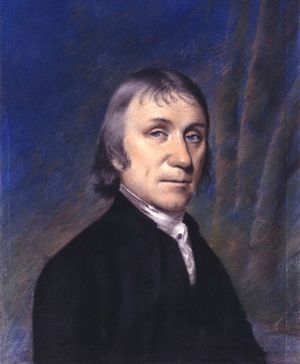Biography
Reverend Joseph Priestley was an English chemist, natural philosopher, separatist theologian, grammarian, multi-subject educator, and liberal political theorist who published over 150 works. He is best known for discovering oxygen. He also identified carbon dioxide, nitrous oxide and six other gases.
Joseph Priestley was born in 13th March 1733 in Fieldhead, Birstall, West Yorkshire, England. He was the second son of Jonas Priestley and Mary Swift. He was christened on 12th August 1733 in St John the Baptist Church, Halifax, West Yorkshire.
Joseph married Mary Wilkinson on 23rd June 1762 in Wrexham, Denbighshire, North Wales. Their children were: [1]
- Sarah Priestley (1763-1831), married William Finch
- Joseph Priestley (1768-1838), married (1) Elizabeth Ryland, (2) Lucinda Barton
- William Priestley (1771-1840), married Margaret Foulke
- Henry Priestley (1774-1796)
His science was integral to his theology, consistently trying to fuse Enlightenment rationalism with Christian theism. He believed that a proper understanding of the natural world would promote human progress and eventually bring about the Christian millennium. Strongly believing in free and open exchange of ideas, Joseph advocated toleration and equal rights for religious Dissenters, which led him to help found Unitarianism in England. [2]
The controversial nature of Joseph's publications, combined with his outspoken support of the French Revolution, aroused such public and governmental suspicion that he was eventually forced to flee with his family in 1791 to London and then, after a mob burned down his Birmingham home and church, in 1794 to the United States of America. [2] After arriving in New York and living briefly in Philadelphia, the couple finally settled in Northumberland, Northumberland County, Pennsylvania, where they were reunited with their three sons, who had emigrated the previous year. Their daughter, Sarah, who was already married, remained in England. Youngest son, Henry, passed away in Northumberland just two years later.
Joseph died on 6th February 1804 in Northumberland at age 70 and was buried in Riverview Cemetery, Northumberland. [3][4] Image of death notice att [5] His home in Northumberland is now a museum dedicated to his life and works. [6]
- Becoming a Scientist
- Joseph Priestley was the son of a lower middle-class cloth finisher born about 200 miles north of London. He was educated at one of the “dissenting academies” and eventually become a Unitarian Church founder. He was a minister, teacher, lecturer and tutor who also wrote on a range of subjects including electricity, which led to Priestley to become a friend of Benjamin Franklin.
- Discovering Air
- From electricity Priestley turned to the study of air. For centuries, natural philosophers had little interest in air. The air pump invention in the mid-1600s, allowing the creation of artificial vacuums, led to the realization that air was more than empty space and to new discoveries about air. In 1754, a Scottish medical student named Joseph Black discovered “fixed air” or carbon dioxide. For the first time in was determined that there was more than one kind of air. British scientists discovering new gases like hydrogen and nitrogen.
- Soda Water Process
- In 1767, Priestley take up a new post as a minister north in Leeds. Priestley’s new congregation put him up initially in a house near a brewery. which provided a convenient source of carbon dioxide and which allowed Priestley to make a series of experiments that led to invent a soda water manufacturing process – carbonation. Industrialists such as Joseph Schweppe capitalized on his discovery but Priestley shared his discovery freely. He mistakenly believed his “windy water” to be a cure for scurvy, which was picked up by a French industrial spy scouting for potential military secrets. He passed it on Antoine Lavoisier.
- Phlogiston Theory
- Lavoisier immediately sized of the potential of the new science of gases to bring about a scientific revolution competing with chemistry’s reigning the—“phlogiston,”—given up during combustion. According to the phlogiston theory, metals were formed when their ores were heated in the presence of charcoal, a rich source of phlogiston.
- A New Gas
- By 1774, Priestley had begun to experiment with red calx of mercury, which seemed to contradict the phlogiston theory. In August 1774, using mercury calx and a burning lens to heat it with sunlight, Priestley found this created a remarkable new gas he called it “dephlogisticated air”, which made candles burn brighter and longer than ordinary air. Two months later, he shared his discovery over dinner with Lavoisier.
- A Man and a Mouse
- Acting on the tip about Priestley’s method for making soda water, Lavoisier had begun his own study of “airs” and made a discovery that threatened to overturn the phlogiston theory – the very foundation of chemistry. Paying close attention to the weights of his experimental ingredients, Lavoisier noticed that metals gain weight as they rust. Even though theory said phlogiston was leaving the metal, the resulting calx was heavier than the metal from which it formed. Puzzled, Lavoisier began a series of experiments that revealed the source of this weight gain - Air, or some part of air, was absorbed into the metal as it rusted. This same “air” seemed to be absorbed by objects as they burned.
For two years, Lavoisier had searched in vain for the identity of this mystery gas. But as he listened to Priestley describe his remarkable new gas over dinner in October 1774, he wondered if this was the gas he’d been looking for. Lavoisier hurried to the local apothecary to buy his own sample of mercury calx. Meanwhile, Priestley returned to England and, with the help of a small friend, discovered that this new gas made his lungs feel “peculiarly light and easy” when breathed in.
- Lavoisier's Oxygen
- Across the English Channel, Lavoisier was performing his own experiments on mercury calx, discovering the same properties Priestley had observed. This new gas, which Lavoisier would soon name “oxygen,” was “more breathable, more combustible and more pure than even the common air in which we live.” He announced his findings with great fanfare at the 1775 Easter meeting of the French Academy of Sciences. But in a move that is still earning him criticism more than two centuries later, Lavoisier failed to acknowledge his debt to Priestley.
- Who Discovered Oxygen?
- While it was Priestley who isolated this new gas, it was Lavoisier who grasped its profound implications. Over the next 15 years, he would make oxygen the foundation of a whole new chemistry, showing that it was a key ingredient in both air and water, and that fire was not an element, as the ancients believed, but a process of combining with oxygen. Lavoisier’s discoveries would eventually overthrow the phlogiston theory – a classic example of a scientific revolution. Yet Priestley, like many any other chemists of the day, stubbornly clung to the old theory, prompting one contemporary to call him “the father of modern chemistry who never acknowledged his daughter.”
Centuries later, scholars continue to debate who deserves credit for discovering oxygen. Should it be Priestley, who brought the world’s attention to the new gas? Or Lavoisier, who understood what the new gas meant? Or a third man, Carl Wilhelm Scheele, a Swedish apothecary who was actually the first to discover the gas he called “fire air” but who didn’t publish his results until after Priestley and Lavoisier? This question about the meaning of “scientific discovery” is explored in a play called Oxygen by chemists Carl Djerassi and Roald Hoffmann – and in the video Who Discovered Oxygen?
- Keeping the Atmosphere Sweet
- While Priestley never accepted the revolutionary importance of his own discovery, he did make a critical finding about the importance of oxygen to life on earth. In a disarmingly simple experiment with what he called a “sprig of mint,” he discovered – with help from his friend Benjamin Franklin – the vital role that plants play in keeping the earth’s atmosphere fit for animal life through the process we now call photosynthesis. It was a fundamental contribution to environmental science.
As his scientific activity waned, Priestley took an ever greater interest in politics, offering vocal support for the American cause in the Revolutionary War and, a decade later, for the French rebels who overthrew King Louis the XVI. By then, Steven Johnson says, Priestley was “one of the most dangerous minds in all of England,” and he would pay a heavy price for his outspoken liberal views. In 1791, on the second anniversary of Bastille Day, a British mob, incensed at Priestley’s support for the French Revolution, burned down his home in Birmingham. He fled to America and spent the last ten years of his life in Pennsylvania. By doing so, Johnson notes, Priestley set a precedent for the many other intellectual exiles who would follow.
Sources
- ↑ Priestley Family Collection Pamphlet, description of the collection donated by Mrs. Temple Fay in 1965 to Dickinson College, Carlisle, PA, Ancestry on pages 14-19
- ↑ 2.0 2.1 Wikipedia: Joseph Priestley
- ↑ Find A Grave Memorial# 7041: Maintained by Find A Grave; Record added Nov 22, 1999
- ↑ BillionGraves, LLC Memorial: Photographer, Chartreusefreak, April 3, 2013; Transcriber, HonestAbe, April 4, 2013
- ↑ Vol. 14: Newspapers: Marriages, Deaths
- ↑ Joseph Priestley House (museum), 472 Priestley Avenue, Northumberland, PA
- The Britannica Guide to The 100 Most Influential Scientists (2007), pp. 112, 115-118, 130.
- Wikipedia article, Joseph Priestley
- Mysteries of Matter, Joseph Priestley: Inspired Forager
- "Pennsylvania, Eastern District Naturalization Indexes, 1795-1952," database with images, FamilySearch (https://familysearch.org/ark:/61903/1:1:KXX1-24J : 8 December 2014), Joseph Priestley, 1799; citing Naturalization, Pennsylvania, United States, NARA microfilm publication M1248 (Washington D.C.: National Archives and Records Administration, n.d.); FHL microfilm 1,412,422.
- "United States Census, 1800", database with images, FamilySearch (https://familysearch.org/ark:/61903/1:1:XHR4-G57 : 10 June 2015), Joseph Priestley, 1800.
- Biography, Dickinson College Archives & Special Collections, Waidner-Spahr Library, Carlisle, PA. This webpage includes links to:
- Joseph Priestley family papers
- Joseph Priestley miscellaneous papers
- Priestley Award papers
- The Priestley Award
- The Gentleman's Magazine: Letters concerning the Birmingham Riots of 1791: https://play.google.com/books/reader?id=j7AUAAAAQAAJ&pg=GBS.PA1022&hl=en_GB
See also:
It may be possible to confirm family relationships. It is likely that these autosomal DNA test-takers will share some percentage of DNA with Joseph:
-
~0.39%
Stephanie Hipple
 :
23andMe
+
AncestryDNA
:
23andMe
+
AncestryDNA
This week's featured connections are Acadians: Joseph is 15 degrees from Joseph Broussard, 16 degrees from Louis Hebert, 21 degrees from Antonine Maillet, 19 degrees from Roméo LeBlanc, 19 degrees from Aubin-Edmond Arsenault, 20 degrees from Louis Robichaud, 17 degrees from Cleoma Falcon, 22 degrees from Rhéal Cormier, 19 degrees from Jack Kerouac, 20 degrees from Maurice Richard, 20 degrees from Ron Guidry and 20 degrees from Beyoncé Knowles-Carter on our single family tree. Login to see how you relate to 33 million family members.
P > Priestley > Joseph Priestley
Categories: Daventry Academy | Riverview Cemetery, Northumberland, Pennsylvania | Lunar Society | Wrexham, Denbighshire | Northumberland County, Pennsylvania | Anglican Priests | Yorkshire, Notables | Food History | Inventors | Birstall, Yorkshire | Notables




You will have to aske her this question My records are similar to yours I would say Can you email me if that is possible and I can give you a descendant report